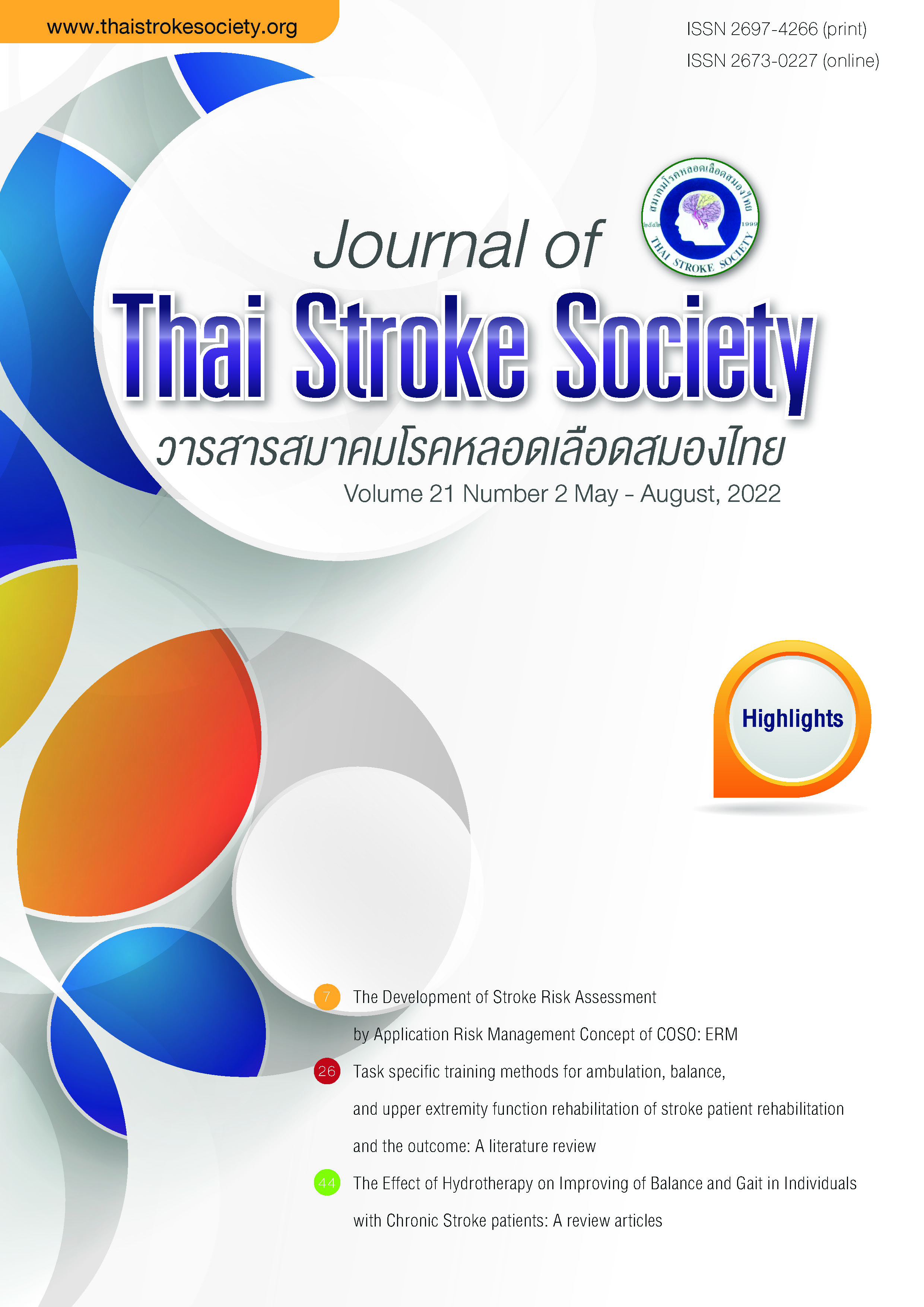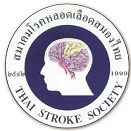The Effect of Hydrotherapy on Improving of Balance and Gait in Individuals with Chronic Stroke patients: A review articles
Keywords:
Hydrotherapy, Balance, Chronic stroke, GaitAbstract
Hydrotherapy is one of a physiotherapy for individuals with stroke. The principle of hydrotherapy is the use of water characteristics (such as hydrostatic pressure, cohesion, and viscosity) in order to gain and apply therapeutic effects to improve movement and impairment in patients. It has been reported that hydrotherapy helps patients to perform basic exercises in the water and develop through activities that would otherwise be challenging on land-based exercise. Studies focusing on the effects of hydrotherapy can be improved the impairments and functional activities in individuals with chronic stroke such as, increasing in muscle strength, improving of balance, increasing weight distribution during standing and walking, and increasing speed of walking. In addition, hydrotherapy also improves in quality of life in individuals with stroke. Therefore, the purpose of this review was to identify the effects of hydrotherapy techniques that have been used to improve balance and gait, as well as to summarize the findings in individuals with chronic stroke. Further, this review can be used as a preliminary information for physiotherapist who need to applied hydrotherapy as a treatment in individuals with chronic stroke.
References
Nichols-Larsen DS, Clark PC, Zeringue A, et al: Factors influencing stroke survivors’ quality of life during subacute recovery. Stroke 2005;36:1480-4.
Mayo NE, Wood-Dauphinee S, Cote R, et al. Activity, participation, and quality of life 6 months poststroke. Arch Phys Med Rehabil 2002; 83(8): 1035-1042.
Takakusaki, K. Neurophysiology of gait: From the spinal cord to the frontal lobe. Mov. Disord. 2013, 28, 1483-1491.
Dobkin, B.H. Rehabilitation after stroke. N. Engl. J. Med. 2005, 352, 1677-1684.
สมชาย รัตนทองคำ, พิสมัย มะลิลา, วรวรรณคำ ลือชา. คู่มือการออกกำลังกายในสระน้ำ. ขอนแก่น: ภาควิชากายภาพบำบัดคณะเทคนิคการแพทย์มหาวิทยาลยขอนแก่น; 2540.
Skinner AT, Thomson AM. Introduction: Duffield’s exercise in water, 3rd edition. London: Bailliere Tindall, 1983:1-2.
ประภาส โพธิ์ทองสุนันท์. ธาราบำบัด กายบริหารในน้ำ. กรุงเทพมหานคร: ฟันนี่พับบลิชชิ่ง; 2533.
Martin J. The Halliwick Method. Physiotherapy 1981; 67: 288-291.
Boyle AM. The Bad Ragaz ring method. Physiotherapy 1981; 67: 265-268.
Ross MC and Presswalla JL. The therapeutic effects of Tai Chi for the elderly. J Gerontol Nurs 1998; 24(2):45-47.
Chan, Kelvin, et al. The effect of water-based exercises on balance in persons post-stroke: a randomized controlled trial. Topics in sTroke rehabiliTaTion, 2017, 24.4: 228-235.
Chu KS, Eng JJ, Dawson AS, Harris JE, Ozkaplan A, Gylfadóttir S. Water-based exercise for cardiovascular fitness in people with chronic stroke: a randomized controlled trial. Arch Phys Med Rehabil. 2004;85(6):870-4.
Zhu Z, Cui L, Yin M, et al. Hydrotherapy vs. conventional land-based exercise for improving walking and balance after stroke: a randomized controlled trial. Clinical Rehabilitation. 2016;30(6):587-593.
Park HK, Lee HJ, Lee SJ, Lee WH. Landbased and aquatic trunk exercise program improve trunk control, balance and activities of daily living ability in stroke: a randomized clinical trial. European Journal of Physical and Rehabilitation Medicine. 2019 Dec;55(6):687-694. DOI: 10.23736/s1973-9087.18.05369-8. PMID: 30370752.
Matsumoto, Shuji, et al. Effect of underwater exercise on lower-extremity function and quality of life in post-stroke patients: a pilot controlled clinical trial. The Journal of Alternative and Complementary Medicine, 2016,22.8:635-641.
Koog D, Lim J-Y, Shin H-I, Paik N-J. The effect of aquatic therapy on postural balance and muscle strength in stroke survivors - a randomized controlled pilot trial. Clinical Rehabilitation. 2008;22(10-11):966-976. Cha H.G.
Cha, Hyun-Gyu, Young-Jun Shin, and Myoung-Kwon Kim. “Effects of the Bad Ragaz Ring Method on muscle activation of the lower limbs and balance ability in chronic stroke: A randomised controlled trial.”Hong Kong Physiotherapy Journal 37 (2017): 39-45.
Goldie PA, Matyas TA, Evans OM, Galea M, Bach TM. Maximum voluntary weight-bearing by the affected and unaffected legs in standing following stroke. Clin Biomech (Bristol, Avon) 1996; 11: 333-42.
Lambeck J, Stanat FC. The Halliwick concept Part I. J Aquatic Ther Phys Ther 2000;2: 7-12.
Richley GP, Cheek WL, Gould ML, et al.: Aquatic physical therapy for balance: the interaction of somatosensory and hydrodynamic principles. J Aquatic Phys Ther, 1997, 5: 4-10.
Downloads
Published
How to Cite
Issue
Section
License
Copyright (c) 2022 Journal of Thai Stroke Society

This work is licensed under a Creative Commons Attribution-NonCommercial-NoDerivatives 4.0 International License.
ข้อความภายในบทความที่ตีพิมพ์ในวารสารสมาคมโรคหลอดเลือดสมองไทยเล่มนี้ ตลอดจนความรับผิดชอบด้านเนื้อหาและการตรวจร่างบทความเป็นของผู้นิพนธ์ ไม่เกี่ยวข้องกับกองบรรณาธิการแต่อย่างใด การนำเนื้อหา ข้อความหรือข้อคิดเห็นของบทความไปเผยแพร่ ต้องได้รับอนุญาตจากกองบรรณาธิการอย่างเป็นลายลักษณ์อักษร ผลงานที่ได้รับการตีพิมพ์ในวารสารเล่มนี้ถือเป็นลิขสิทธิ์ของวารสาร





